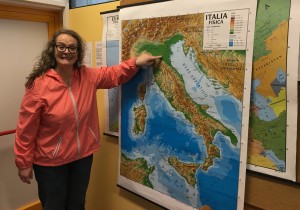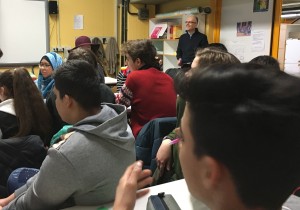
Our group returned to the Besta School on Wednesday, February 24th in the early morning. We were looking forward to learning more about the institution’s initiatives in integrating diversely ethnic students, with particular attention given to newly arrived students from families with no Italian language background. Although this was a worthwhile focus, the school also provides opportunities to all students to learn English as well as German.


We started our day having the opportunity to interact with 24 students during their English lesson. At first, we struggled to communicate with the students, but within minutes we were able to surpass this initial challenge by using rhymes, gestures and music to truly interconnect, despite the obvious language barriers. The continual attempts and the whole group’s determination to understand and be understood, truly paid off as we worked on communicating individually and collectively.

Despite the initial timidity, the difficulties we had with our language skills became secondary. We truly felt interconnected despite of and also because of our limited abilities. The middle school age students were learning and practicing their English skills, often in need of help with words and expressions. Dickinson students and professors also needed help, since our ability to speak and understand Italian varied tremendously. This setting was extremely advantageous as we became interdependent in a most delightful exchange.
Our first common assignment was to work individually, creating our own version of George Ella Lyon’s poem “Where I Am From”. This would give each of the students an excellent opportunity to share something about themselves in a creative and self-expressive way.
Some ideas were written on the chalkboard in order to help the brainstorming writing process. Some of the words that were written on the board in both English and Italian were different names, types of music, food items, various feelings, smells, rituals, beliefs and activities.


All students were invited to share a few lines of their creation in front of the group. Dickinson students shared some of their lines and Besta School students read some of theirs. This particular exercise emphasized the diverse nature and meaning of identity. It also helped active participants and spectators to feel safe as a unique person, while exploring their origins and life memories. This can be a sensitive topic and approach for the middle school age group, since they usually just try to blend in and belong without standing out.
For our Mosaic group it was very important to have a more accurate outlook on origins and migration experiences. Besta School students revealed a variety of backgrounds ranging from locals from Bologna (in the North of Italy) to southerners from Palermo. Students also shared their families origin from a variety of countries such as Bangladesh, China, India, Pakistan and Albania, among others.
The second class we attended was a Math Lab, where a few students who are also learning Italian took turns participating in a practical exercise applying the concept and mathematical vocabulary they had been introduced to. It was clear that some of them were struggling but they were willing to attempt solving the math problems. The teacher used visual learning as the basis for class involvement and seemed very committed to student success despite the language barrier.